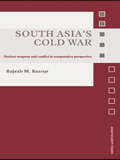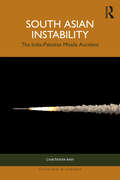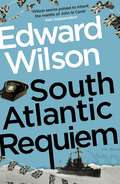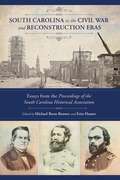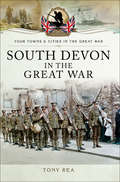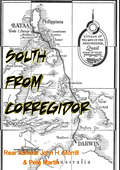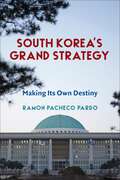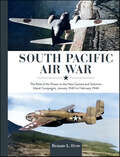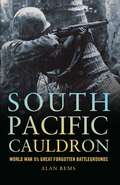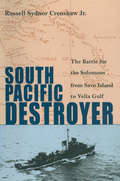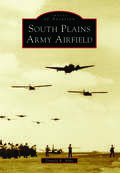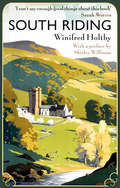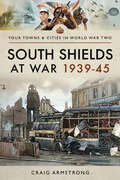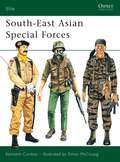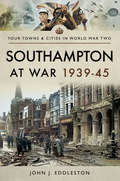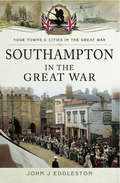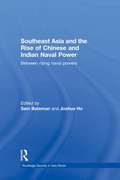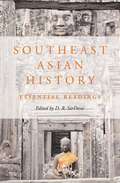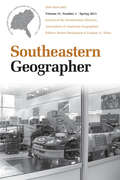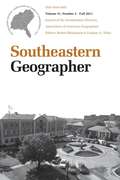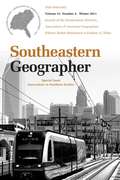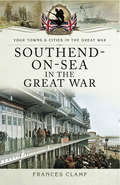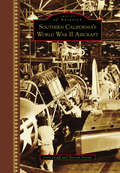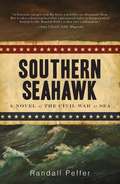- Table View
- List View
South Asia's Cold War: Nuclear Weapons and Conflict in Comparative Perspective (Asian Security Studies)
by Rajesh M. BasrurThis book is a ground-breaking analysis of the India-Pakistan nuclear confrontation as a form of ‘cold war’ – that is, a hostile relationship between nuclear rivals. Drawing on nuclear rivalries between similar pairs (United States-Soviet Union, United States-China, Soviet Union-China, and United States-North Korea), the work examines the rise, process and potential end of the cold war between India and Pakistan. It identifies the three factors driving the India-Pakistan rivalry: ideational factors stemming from partition; oppositional roles created by the distribution of power in South Asia; and the particular kind of relationship created by nuclear weapons. The volume assesses why India and Pakistan continue in non-crisis times to think about power and military force in outmoded ways embedded in pre-nuclear times, and draws lessons applicable to them as well as to other contemporary nuclear powers and states that might be engaged in future cold wars.
South Asian Instability: The India-Pakistan Missile Accident (South Asia in Context)
by Chaitanya RaviThis book examines key concerns in South Asian security through a fine-grained history of the accidental firing of a missile and its aftermath between two nuclear-armed states—India and Pakistan—with tense relations in March 2022. It consolidates the official statements, media discourse and debates within the strategic communities in both countries into a coherent narrative. It looks at the role of key institutions in the crisis such as the Indian Air Force (IAF), The Directorate of Air Staff Inspection-IAF, Indian Ministry of Defence (MOD), Pakistan Air Force (PAF), Pakistani Foreign Office (FO), Inter-Services Public Relations (ISPR) and others. The book also examines the missile accident’s coverage in the international media and discussions in the global think-tank community.Drawing on a host of resources, including published interviews of government officials, analyses in media, and strategic communities in India, Pakistan and the United States, this volume will be key reading for scholars and researchers of military and strategic studies, politics and international relations, public policy and South Asian studies.
South Atlantic Requiem (William Catesby)
by Edward WilsonA brilliant, eye-opening espionage thriller by a former special forces officer 'now at the forefront of spy writing''The thinking person's John le Carré' Tribune 'Edward Wilson seems poised to inherit the mantle of John le Carré' Irish Independent'More George Smiley than James Bond, Catesby will delight those readers looking for less blood and more intelligence in their spy thrillers' Publishers WeeklyIt is 1982 and the British prime minister and the Argentine president are both clinging to power. Downing Street, having ignored alarm bells coming from the South Atlantic, finds itself in a full-blown crisis when Argentina invades the remote and forgotten British territory of the Falklands Islands. Catesby is dispatched urgently to prevent Argentina from obtaining more lethal Exocet missiles by fair means or foul. From Patagonia to Paris, from Chevening to the White House, Catesby plays a deadly game of diplomatic cat and mouse determined to avert the loss of life. The clock is ticking as diplomats and statesmen race for a last-minute settlement while the weapons of war are primed and aimed. Edward Wilson's stunning new spy thriller brilliantly evokes the intricate world of high-stakes espionage with a rare authenticity and deeply-felt sympathy for the human cost and tragedy of conflict.'Gets nearer to the truth of what happened in the Falklands War than any of the standard histories. Highly recommended' Clive Ponting'A classic of the genre . . . as good as espionage thriller writing gets' NB Magazine'A stunning and ingenious book' Crime ReviewPraise for Edward Wilson:'Stylistically sophisticated . . . Wilson knows how to hold the reader's attention' W.G. Sebald'A reader is really privileged to come across something like this' Alan Sillitoe'All too often, amid the glitzy gadgetry of the spy thriller, all the fast cars and sexual adventures, we lose sight of the essential seriousness of what is at stake. John le Carré reminds us, often, and so does Edward Wilson' Independent
South Carolina in the Civil War and Reconstruction Eras: Essays from the Proceedings of the South Carolina Historical Association
by Michael Brem Bonner and Fritz HamerAn anthology of important scholarship on the Civil War and Reconstruction eras from the journal Proceedings of the South Carolina Historical Association.Since 1931, the South Carolina Historical Association has published an annual, peer-reviewed journal of historical scholarship. In this volume, past SCHA officers of Michael Brem Bonner and Fritz Hamer present twenty-three of the most enduring and significant essays from the archives, offering a treasure trove of scholarship on an impressive variety of subjects including race, politics, military events, and social issues.All articles published in the Proceedings after 2002 are available on the SCHA website, but this volume offers, for the first time, easy access to the journal’s best articles on the Civil War and Reconstruction up through 2001. Preeminent scholars such as Frank Vandiver, Dan T. Carter, and Orville Vernon Burton are among the contributors to this collection, an essential resource for historical synthesis of the Palmetto State’s experience during that era.
South Devon in the Great War (Your Towns And Cities In The Great War Ser.)
by Tony ReaSouth Devon in the Great War provides the first definitive history of events in this part of Devon during the First World War, with more than fifty pictures, some unpublished for 100 years. The author's succinct and engaging text is further enhanced by a unique set of then and now photographs, and provides readers with an incomparable pictorial overview of events on the Home FrontTo the casual observer, south Devon may have seemed an agricultural backwater of Britain during the war, important in but two respects; the Britannia Royal Naval College at Dartmouth and the Royal Naval base at Devonport. However, a closer and more considered gaze reveals significant changes. By late 1915 many of the young men and, significantly, almost all of the horses had gone away to war. Older men and many women now farmed the land, aided by German PoWs. Dartmoor Gaol became home to hundreds of Conscientious Objectors put to work on the quarries whilst large and medium sized country houses were converted to hospitals and convalescent homes.Not only does South Devon in the Great War detail these changes, it also explains how the local regiment responded to the call to arms of a whole nation. Within these pages the reader will find many personal tales of sacrifice, loss and grief. Most of all, however, readers will be ultimately uplifted by tales of the endurance of the human spirit.
South From Corregidor [Illustrated Edition]
by Pete Martin Rear Admiral John H. MorrillIncludes the Second World War In The Philippines Illustration Pack - 237 maps, plans and photos.This is the story of Lt.-Comm. John Morrill II and 18 men of the minesweeper Quail, who refused to accept the unenviable hospitality of the Imperial Japanese army as Prisoners Of War in 1942. When the American defenders of the Philippines, having fought courageously, eventually surrendered, Morrill and his men faced a vast stretch of enemy-occupied Pacific between them and freedom. Starting with only a barely seaworthy motor launch for their only transportation, they set out on their epic journey...
South Korea's Grand Strategy: Making Its Own Destiny (Contemporary Asia in the World)
by Ramon Pacheco PardoSince the end of the Cold War, South Korea has taken on a greater role in global affairs. Ramon Pacheco Pardo provides a groundbreaking analysis of South Korea’s foreign policy from its transition to democracy in the late 1980s through the present day, arguing that the country’s approach to the world constitutes a grand strategy.This book examines the key factors and goals that shape South Korea’s long-term strategy, with analysis that brings together its diplomatic, military, economic, and soft-power components. Pacheco Pardo shows that South Korea’s fundamental aim has been to move beyond its past as a “shrimp among whales” and instead attain autonomy and freedom of action. He explores how South Korean leaders across parties and governments have pursued security, prosperity, and status. Pacheco Pardo tracks South Korea’s core relationships with North Korea, the United States, and China, and he details the country’s objectives and policies across East Asia, the Asia-Pacific region, and the rest of the world.Drawing on in-depth interviews with past and present policy makers, this book presents an analytical account of how South Korean strategy is made and practiced. It expertly lays out South Korea’s grand strategy and, more broadly, makes a compelling case that middle powers like South Korea can implement grand strategies.
South Pacific Air War: The Role of Airpower in the New Guinea and Solomon Island Campaigns, January 1943 to February 1944
by Richard DunnA new history of the South Pacific campaigns based primarily upon primary source material
South Pacific Cauldron
by Alan RemsThe war in the South Pacific in its entirety has remained remarkably neglected by historians. This is the first comprehensive narrative history covering all land, sea and air operations in the theater to the end of World War II.While Guadalcanal is familiar to most Americans and the Kokoda Trail is well known to Australians, the war in the South Pacific includes many now forgotten operations that deserve to be well remembered. Also, significantly, the official Australian history of World War II correctly observed that Australia's part in the Pacific war is barely mentioned in American histories. This volume finally brings the major Australian contribution to the fore, recognizing too the valuable part played by New Zealand forces in the Solomons campaign. The dramatis personae could hardly be improved upon, including brilliant and imperious General Douglas MacArthur, audacious and profane Admiral William "Bull" Halsey, and bibulous and indelicate Australian General Thomas Blamey. No less interesting are many others that will be mostly new to readers, many from the Japanese side, including indomitable generals Noboru Sasaki and Hatazo Adachi. As for the fighting men, many of their stories are captured in accounts of the actions for which they were awarded the Congressional Medal of Honor, Victoria Cross, and other decorations for valor.Three chapters are of special interest. Based on the author's archival research, Chapter 10 tells through confidential correspondence the remarkable story of the death of the top Marine general in the Pacific and its cover-up sanctioned by Halsey. Chapter 23 concerns the first African-American ground troops in combat and tells how the performance of one company on Bougainville resulted in a reversal of that policy. Chapter 26 involves Blamey's questionable decision to eradicate the isolated Japanese forces, forcing his Australian militia to risk their lives knowing their sacrifices could make no difference in the outcome of the war.
South Pacific Destroyer
by Russell Crenshaw Jr.Russell Crenshaw's riveting account of the savage night battle for the Solomon Islands in early 1943 offers readers a unique insider's perspective from the decks of one of the destroyers that bore the brunt of the struggle. Drawing on his experience as a gunnery officer in the USS Maury, his vivid, balanced, and detailed narrative includes the Battle of Tassafaronga in November 1942 and Vella Gulf in August 1943, actions that earned his warship a Presidential Unit Citation and sixteen battle stars. Crenshaw also discusses the impact of radar and voice radio, the shortcomings of U.S. torpedoes and gunfire, and the devastating effectiveness of Japan's super torpedo.
South Plains Army Airfield (Images of Aviation)
by Donald R. AbbeSouth Plains Army Airfield in Lubbock, Texas, was a major training base for US Army Air Force glider pilots during World War II. Approximately 80 percent of the roughly 6,000 pilots trained to fly the combat cargo glider received their advanced training and were awarded their "G" Wings at SPAAF, as it was known. The base was conceived, built, used, and then closed in a short five-year period during World War II. Today, little remains to remind one of the feverish and important military training program that once took place on the flat, featureless South Plains of Texas. During World War II, American military strategy and tactics included a significant airborne component. Major invasions, such as D-Day at Normandy, were preceded by huge aerial fleets carrying paratroopers and their equipment. These airborne invasion fleets sometimes exceeded well over 1,000 Allied gliders. The American airborne forces depended upon an ungainly looking aircraft, the CG-4A glider, to carry the vehicles, munitions, and reinforcements needed to survive. The pilots who flew them learned their trade at South Plains Army Airfield.
South Riding (Virago Modern Classics #28)
by Winifred HoltbyWhen Sarah Burton returns to her hometown as headmistress she is full of ambition, determined to create a great school and to inspire her girls to take all they can from life. But in the aftermath of the First World War, the country is in depression and ideals are hard won. Lydia Holly, the scholarship girl from the shacks, is the most brilliant student Sarah has ever taught, but when her mother's health fails, her education must be sacrificed - there is nobody else to care for the children.Robert Carne of Maythorpe Hall stands for everything Sarah despises: his family has farmed the South Riding for generations, their position uncontested. Yet Sarah cannot help being drawn to this proud, haunted - and almost ruined - man.South Riding is a rich, panoramic novel, bringing vividly to life a rural community on the brink of change.
South Shields at War 1939–45 (Your Towns & Cities in World War Two)
by Craig ArmstrongA tribute to the WWII contributions made by this northeastern English town from the historian and author of RAF Bomber Command at War 1939-1945.South Shields and its near neighbors such as Jarrow were key communities in the national war effort, despite their relatively small size. Located on the East Coast, South Shields was situated at the key entry to the strategically important River Tyne and was well defended against enemy attack. Huge numbers of South Shields men and women volunteered for wartime service, while many others worked in vital wartime industries. The town had a particularly high number of men serving in the Merchant Navy and the South Shields mariners suffered very heavy casualties. South Shields also had a multi-cultural population with a large number of foreign (or aliens as they were referred to) seamen and an especially large and active Yemeni community. Indeed, South Shields was to become the first town in Britain to have a purpose-built mosque. Although there were tensions amongst the population due to cultural and racial differences, the Yemeni community played a considerable and loyal role in the war effort.The book also looks at the considerable contribution made by the men and women who volunteered for the ARP and Civil Defence Services. The towns of Tyneside, including South Shields, were heavily attacked by the Luftwaffe and the blitzes of 1941 hit the town particularly hard. No member of the community was left untouched by the war, whether they were evacuees, workers, servicemen or just civilians struggling to maintain a home in wartime Britain.
South Shields at War 1939–45 (Your Towns & Cities in World War Two)
by Craig ArmstrongA tribute to the WWII contributions made by this northeastern English town from the historian and author of RAF Bomber Command at War 1939-1945.South Shields and its near neighbors such as Jarrow were key communities in the national war effort, despite their relatively small size. Located on the East Coast, South Shields was situated at the key entry to the strategically important River Tyne and was well defended against enemy attack. Huge numbers of South Shields men and women volunteered for wartime service, while many others worked in vital wartime industries. The town had a particularly high number of men serving in the Merchant Navy and the South Shields mariners suffered very heavy casualties. South Shields also had a multi-cultural population with a large number of foreign (or aliens as they were referred to) seamen and an especially large and active Yemeni community. Indeed, South Shields was to become the first town in Britain to have a purpose-built mosque. Although there were tensions amongst the population due to cultural and racial differences, the Yemeni community played a considerable and loyal role in the war effort.The book also looks at the considerable contribution made by the men and women who volunteered for the ARP and Civil Defence Services. The towns of Tyneside, including South Shields, were heavily attacked by the Luftwaffe and the blitzes of 1941 hit the town particularly hard. No member of the community was left untouched by the war, whether they were evacuees, workers, servicemen or just civilians struggling to maintain a home in wartime Britain.
South-East Asian Special Forces
by Kenneth Conboy Simon MccouaigElite units have long been prominent in the armies of South-East Asia and, given the turmoil in the region since the 1960s, these forces have had ample opportunity to be tested in combat. Acknowledged expert on South-East Asia Ken Conboy outlines the history, organization and insignia of Vietnamese, Cambodian, Indonesian, Malaysian and various other South-East Asian special forces from their origins up until the late 80s, covering such groups as the Vietnamese Luc Luong Dac Biet ('Special Forces') and Lien Doi Ngoui Nhia underwater demolition team and the Cambodian Airborne Brigade Group.
Southampton at War, 1939–45
by John J. EddlestonIn the Great War of 1914–1918, Southampton played a vital role in the war effort. Designated as Port Number One it saw hundreds of thousands of men and many tons of equipment sail for the fields of Belgium and France.The Second World War was a completely different type of war. Hitlers blitzkrieg tactics led to a more mobile war and, arguably for the first time, airpower played a crucial role. Whoever had superiority in the air had a massive advantage in any particular theater, or battle. This does not, however, mean that Southamptons role was relegated to a minor one.Southamptons men still enlisted in their hundreds. Her women took over roles in factories, on buses and trams, and many of them also served in the armed forces. Her citizens formed defense groups and helped to watch for the enemy invasion and those same citizens suffered greatly when the bombs fell. The Southampton Blitz claimed many lives and this, perhaps, was the greatest difference the town saw in this second global conflagration. It is true that her citizens had also served in the Great War but now, through the efforts of the Luftwaffe, these men, women and children were now also in the front line.Hitler once described Germanys plans as total war. The phrase is certainly apt when one considered how the towns and cities of Britain suffered during the Nazi supremacy. One of those towns was Southampton, a town that once again, just 20 short years after she had given so much, had to brace herself for long years of war in which every single person had their role to play.And once again, Southampton and her citizens were not found wanting.
Southampton in the Great War (Your Towns & Cities in the Great War)
by John J. EddlestonMany troops passed through Southampton on their way to the Western Front and it played a vital role as a staging post for departing troops and those returning badly injured.Many of men from Southampton also joined up and the enormity of human sacrifice that the families of Southampton were committed to as the war stretched out over the next four years was immense. The Great War affected everyone. At home there were wounded soldiers in military hospitals, refugees from Belgium and later on German prisoners of war. There were food and fuel shortages and disruption to schooling. The role of women changed dramatically and they undertook a variety of work undreamed of in peacetime. Meanwhile, men serving in the armed forces were scattered far and wide. Extracts from contemporary letters reveal their heroism and give insights into what it was like under battle conditions.
Southeast Asia and the Rise of Chinese and Indian Naval Power: Between Rising Naval Powers (Routledge Security in Asia Pacific Series)
by Sam Bateman Joshua HoThis book examines the emerging maritime security scene in Southeast Asia. It considers highly topical implications for the region of possible strategic competition between China and India - the rising naval powers of Asia - with a possible naval "arms race" emerging between these countries both with naval force development and operations. As part of its "Look East" policy, India has deployed naval units to the Pacific Ocean for port visits and exercises both with East Asian navies and the US Navy, but India is also concerned about the possibility of the Chinese Navy operating in the Indian Ocean. Even as the US-India defence relationship continues to deepen, the US and China are struggling to build a closer links. China’s and India’s strategic interests overlap in this region both in maritime strategic competition or conflict – which might be played out in the Bay of Bengal, the Malacca and Singapore Straits and the South China Sea. The sea lines of communication (SLOCs) through Southeast Asian waters constitute vital "choke points" between the Indian and Pacific Oceans carrying essential energy supplies for China and other Northeast Asian countries. Any strategic competition between China and India has implications for other major maritime players in the Pacific and Indian Oceans, especially Australia, the Republic of Korea and Japan, as well as the US. This book identifies possible cooperative and confidence-building measures that may contribute to enhanced relations between these two major powers and dampen down the risks associated with their strategic competition.
Southeast Asian History
by D. R. SardesaiDesigned to stand on its own, or to accompany the seventh edition of D. R. SarDesai's Southeast Asia: Past and Present, this updated reader includes classic and recent works on the history of Southeast Asia. <P><P> SarDesai has selected literary and historical writings that address crucial controversies in the region of Southeast Asia. The readings are organized in four sections--Cultural Heritage, Colonial Interlude, Nationalist Response, and the Fruits of Freedom--and cover the entire range of Southeast Asian history from ancient to contemporary times. Geographically, the book includes Myanmar, Thailand, Malaysia, Brunei, Singapore, Indonesia, East Timor, Laos, Cambodia, Vietnam, and the Philippines. The revised second edition retains the most popular readings from the first edition, while replacing some of the historical chapters, updating the contemporary and recent coverage, and adding new readings to pertinent subject areas. Southeast Asian History: Essential Readings provides valuable context and critical background to events of this region.
Southeastern Geographer, Volume 51, #1 (Spring #2011)
by Robert Brinkmann Graham A. TobinTable of Contents, Volume 51, Number 1:<P><P> Introduction: Robert Brinkmann and Graham Tobin<P><P> Economic Geography in the South<P> Guest Editor: James O. Wheeler<P><P> Introduction: Economic Geography in the South<P> James O. Wheeler<P><P> The Furniture Foothills and the Spatial Fix: Globalization in the Furniture Industry<P> Susan M. Walcott<P><P> Mapping NASCAR Valley: Charlotte as a Knowledge Community<P> Ron L. Mitchelson and Derek H. Alderman<P><P> The Southern Culture of Risk Capital: The Path Dependence of Entrepreneurial Finance<P> William Graves<P><P> Renewable Energy in North Carolina: The Potential Supply Chain and Connections to Existing Renewable and Energy Efficiency Firms<P> Keith G. Debbage and Jacob F. Kidd<P><P> African American and Hispanic Self-Employment in the Charlotte Metropolitan Area<P> Qingfang Wang<P><P> Papers<P><P> Hurricane Katrina as a Lens for Assessing Socio-Spatial Change in New Orleans <P> Case Watkins and Ronald R. Hagelman, III<P><P> Drought and Other Driving Forces behind Population Change in Six Rural Counties in the United States<P> Justin T. Maxwell and Peter T. Soule<P><P> Mapping Existing and Potential River Cane (Arundinaria gigantea) Habitat in Western North Carolina<P> Joni L. Bugden, Christopher D. Storie, Carey L. Burda<P><P> Under-Tapped? An Analysis of Craft Brewing in the Southern United States <P> James Baginski and Thomas L. Bell<P><P> Citizenship Contested: The 1930s Domestic Migrant Experience in California's San Joaquin Valley <P> Toni Alexander<P><P> Book Reviews: Perspectives on Carbon Trade<P> Reviewed by Mary Finley-Brook<P><P> Carbon Markets: An International Business Guide <P> Arnaud Brohe, Nick Eyre, and Nicholas Howarth<P><P> Carbon Trading: How It Works and Why It Fails <P> Tamra Gilbertson and Oscar Reyes
Southeastern Geographer, Volume 51, #3 (Fall #2011)
by Robert Brinkmann Graham A. TobinTable of Contents for Fall 2011:<P><P> Assessing Spatial Hydrological Data Integration to Characterize Geographic Trends in Small Reservoirs in the Apalachicola- Chattahoochee-Flint River Basin<P> Amber Ignatius and Jon Anthony Stallins<P><P> Spatial Patterns of Ecological Integrity in South Carolina Watersheds<P> John A. Kupfer and Peng Gao<P><P> The 2007 Mid-South Summer Drought and Heat Wave in Historical Perspective<P> Gregory B. Goodrich, J. Kyle Thompson, Stanley D. Wingard, and Kylie J. Batson<P><P> City Limits? The Impact of Annexation on the Frequency of Municipal Incorporation in North Carolina<P> Russell M. Smith<P><P> GIS Educational Opportunities at Historically Black Colleges and Universities in the United States<P> Rakesh Malhotra and Gordana Vlahovic <P><P> A Geography of Appalachian Identity<P> Christopher A. Cooper, H. Gibbs Knotts, and Katy L. Elders<P><P> Geographic Note<P> Posted Redux: Campaign Signs, Race, and Political Participation in Mississippi, 2008<P> J.O. Joby Bass<P><P> Book Reviews<P> ----------------------------------<P> Southeastern Geographer is published by UNC Press for the Southeastern Division of the Association of American Geographers (www.sedaag.org). The quarterly journal publishes the academic work of geographers and other social and physical scientists, and features peer-reviewed articles and essays that reflect sound scholarship and contain significant contributions to geographical understanding, with a special interest in work that focuses on the southeastern United States.
Southeastern Geographer, Volume 51, #4 (Winter #2011)
by Robert Brinkmann Graham A. TobinTable of Contents for Volume 51, Number 4 (Winter 2011)<P><P> Introduction: With Thanks <P> Graham A. Tobin and Robert Brinkmann<P><P> Innovations in Southern Studies within Geography <P> Derek H. Alderman and William Graves<P><P> The Bible Belt in a Changing South: Shrinking, Relocating, and Multiple Buckles <P> Stanley D. Brunn, Gerald R. Webster, and J. Clark Archer<P><P> Emerging Patterns of Growth and Change in the Southeast <P> Benjamin J. Shultz<P><P> Geographies of Race in the American South: The Continuing Legacies of Jim Crow Segregation <P> Joshua F. J. Inwood<P><P> Jim Crow, Civil Defense, and the Hydrogen Bomb: Race, Evacuation Planning, and the Geopolitics of Fear in 1950s Savannah, Georgia <P> Jonathan Leib and Thomas Chapman<P><P> Representing the Immigrant: Social Movements, Political Discourse, and Immigration in the U.S. South <P> Jamie Winders<P><P> Water, Water, Everywhere? Toward a Critical Water Geography of the South <P> Christopher F. Meindl<P><P> The Politics of Mobility in the South: A Commentary on Sprawl,Automobility, and the Gulf Oil Spill <P> Jason Henderson<P><P> Southeastern Geographer is published by UNC Press for the Southeastern Division of the Association of American Geographers (www.sedaag.org). The quarterly journal publishes the academic work of geographers and other social and physical scientists, and features peer-reviewed articles and essays that reflect sound scholarship and contain significant contributions to geographical understanding, with a special interest in work that focuses on the southeastern United States.
Southend-on-Sea in the Great War (Your Towns & Cities in the Great War)
by Frances Clamp'A fortified place'. This is not the way we usually think of Southend-on-Sea but it was the description used by the Germans during the Great War. Built beside the Thames Estuary and with the Shoebury Garrison to the east, Rochford Aerodrome to the north and the longest pleasure pier in the world to the south, it was regarded as a legitimate target. During the war the pier was used as an embarkation point for British soldiers about to be transported to France.Southend-on-Sea in the Great War looks at the lives of the ordinary people of the town who coped with the new and unexpected problems that arose. A number of large hotels became hospitals for wounded military. The imposing Palace Hotel became the Queen Mary Royal Naval Hospital and it even received a visit from the Queen herself. The role of women changed. Some worked in munitions factories or cleaned trains whilst others supported the local hospitals. They coped with the constant fear of the loss of loved ones and dealt with ever increasing food shortages.Bombs were dropped on the town, the worst raid being in August 1917 when thirty-two people were killed and forty-four injured. Learn more about this tragic event and other accounts of the impact of the Great War on Southed-on-Sea in the pages of this fascinating book.Southend was at the sharp end of activity during the First World War. Bombed by Zeppelin and Gotha, it also received some of the first German POWs and acted as a camp for soldiers departing to the trenches across the Channel. This book explores how the experience of war impacted on this Coastal Town, from the initial enthusiasm for sorting out the German Kaiser in time for Christmas 1914, to the gradual realization of the enormity of human sacrifice the families of Southend were committed to as the war stretched out over the next four years. The Great War affected everyone. At home there were wounded soldiers in military hospitals, refugees from Belgium and later on German prisoners of war. There were food and fuel shortages and disruption to schooling. The role of women changed dramatically and they undertook a variety of work undreamed of in peacetime. Meanwhile, men serving in the armed forces were scattered far and wide. Extracts from contemporary letters reveal their heroism and give insights into what it was like under battle conditions.
Southern California's World War II Aircraft (Images of Aviation)
by Cory Peyton Graff Patrick Thomas DevineThe cities of Los Angeles and San Diego were boomtowns during World War II. California aviation companies designed many of the greatest combat aircraft of the era, and bustling armies of women and men helped quickly churn them out by the thousands. An astounding 41 percent of all US warplanes came from California drawing boards during the war. These planes saw combat service everywhere--from the deserts of North Africa to the frozen tundra of Alaska. Southern California planes were the first to bomb Japan. They turned the tide at the Battle of Midway and dropped paratroopers behind enemy lines on D-Day. They flew tons of fuel, ammunition, and supplies over the treacherous Himalayan Mountains, relentlessly hounded enemy submarines and ships, and helped smash Nazi Germany's war-making industry with "thousand plane raids."
Southern Seahawk: A Novel of the Civil War at Sea
by Randall PefferSouthern Seahawk, the first novel in the Seahawk Trilogy, grows from the true story of Commander Raphael Semmes’ rise to infamy, becoming the Union’s “Public Enemy Number One.”In June, 1861, Semmes’ Confederate cruiser Sumter makes a daring escape through the Federal Blockade of the Mississippi. So begins the commander’s career as the Southern Seahawk. With a hand-picked crew of Southern officers and mercenary seamen, Semmes seizes eight enemy ships in four days, a record never surpassed by any other captain of a warship. By the time the cruises of the Sumter and her successor Alabama end, Semmes will have taken and burned more than eighty prizes, making him the most successful maritime predator in history.For two and a half years Semmes eludes a pack of pursuers and almost single-handedly drives marine insurance rates so high in the North, that many Yankee ships refuse to sail until he is caught Back in Washington, Semmes’ predations fuel feuds within the Lincoln cabinet and incite the spy games of historical figures like courtesans Rose Greenhow, Betty Duval, detective Allan Pinkerton and the commander’s mistress.
